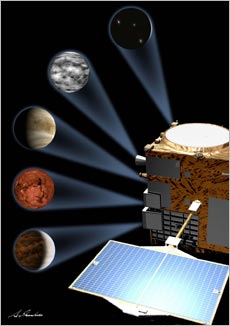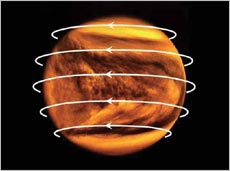


Venus
Diameter: 12103.6km
Mass (Earth=1): 0.815
Density: 5.24 g/cm3
Gravity (Earth=1): 0.91
Sidereal orbit period: 224.7days
Sidereal Rotation Period: 243.01days
Image of Venus taken by U.S. Pioneer (Courtesy of NASA/JPL)

Image of Venusian surface taken by the Soviet Union's Venera 13 (Courtesy of NASA/NSSDC)

Topographic map of Venus by U.S. Magellan (Courtesy of NASA/NSSDC)
Q. What is the primary mission objective of PLANET-C?
PLANET-C is Japan's first Venus probe, designed to study the dynamics of the atmosphere and to establish the meteorology of Venus. Japan will be the first nation to observe the Venusian atmosphere in terms of fluid dynamics.
The mechanics of atmospheric circulation are not yet fully understood. Venus rotates very slowly, completing one rotation every 243 days. Yet in contrast, its atmosphere circulates around the planet in approximately four days, at speeds of up to 100 meters per second. This means that the rotation velocity of the atmosphere is 60 times greater than that of the solid surface of the planet. This unique phenomenon is called super-rotation. Conventionally speaking, if a planet's solid mass stops rotating or slows down significantly, the atmospheric circulation should also stop or slow down, due to friction between the ground surface and the atmosphere. But Venus's atmosphere keeps rotating around it at high speed. In order to understand this anomalous phenomenon, we will investigate the cloud dynamics and the wind velocity distribution of Venus.
Q. What prompted you to explore Venus?
We know about Venus to a certain degree thanks to Russian and U.S. Venus missions thus far, but there is still a lot to learn about the planet.
The former Soviet Union sent many probes to Venus from the 1960s to the 1980s. Their Venera (Venus in Russian) series used atmospheric entry probes to study the atmospheric composition, and to image the planet's surface during descent. Although Venus was too hot for the probes to last for more than an hour, their observations gave us a rough idea about the composition, temperature, and pressure of the Venusian atmosphere. And the U.S. probe Magellan, which took off for Venus in 1989, radar-mapped Venus's surface precisely. But after these missions, Venus was neglected for more than 10 years. So that's why we decided to target the Venusian atmosphere, to comprehensively study a phenomenon no one has yet understood. We're aiming to achieve results that will garner world recognition, by doing something original rather than following what other countries have done. And in order to achieve this we've built the satellite and observation tools with Japanese technology.
Also, we thought that it would be valuable to add another terrestrial planet, such as Venus, to Japan's planetary exploration program, especially after our Nozomi (PLANET-B) Mars mission. In comparative planetology, it is essential to collect data from different locations. People often ask why we don't focus our research on one planet; the answer is that our goal now is a greater understanding of planetary meteorology rather than a more in-depth understanding of any single planet. This follows the notion that, if you want to really understand the principles of volcanic activity, for example, you need to study more than one volcano.

PLANET-C images different aspects of Venus at different wavelengths: (from top) lightning in visible light, cloud temperature map in mid-infrared, chemical composition at cloud top in ultraviolet, ground surface in near-infrared, and lower atmosphere in near-infrared (Courtesy of Akihiro Ikeshita)

Super rotation: strong winds that circulate around Venus
Q. How are you going to study the Venusian atmosphere?
Venus's surface is invisible under a thick layer of sulfuric acid clouds at the altitude range of 45 to 70 kilometers. Venus looks bright from the Earth, but that's because these clouds are reflecting the Sun. Also, Venus's surface temperature is extremely high due to the greenhouse effect caused by CO2, which is the primary component of the Venusian atmosphere. Infrared light is emitted from Venus's surface, but the radiation cannot break through the clouds. Instead it is absorbed by them and by the carbon dioxide atmosphere. However, scientists discovered about 15 years ago that some specific infrared frequency bands do penetrate Venus's atmosphere. Infrared light has a wavelength longer than 0.7 μm (a micrometer is one thousandth of a millimeter), and studies have shown that infrared light of 1.0, 1.7, and 2.3 μm, for example, can penetrate the thick clouds of Venus without being absorbed by carbon dioxide in the atmosphere. With these infrared rays emitted from Venus' surface, it's possible to observe the shadow of Venus's clouds. And by studying the movements of the cloud shadow, we will be able to learn the dynamics of the Venusian atmosphere. Furthermore, we'll be able to see different phenomena on Venus by observing it in different wavelengths, such as infrared and ultraviolet. To study the dynamics of the Venusian atmosphere in three dimensions, the PLANET-C spacecraft uses different wavelengths to simultaneously image an atmospheric phenomenon at different altitudes. It will also monitor the momentum of the Venusian atmosphere, in other words, the dynamics of the atmospheric circulation.
Also, the randomness of Venusian clouds reflects irregularity within Venus's atmosphere. Clouds of different thicknesses may have different airflows, temperatures, or atmospheric compositions. A famous hypothesis on Venus's super-rotation holds that the atmosphere is accelerated by angular momentum that is increased by such diverse interactions in the atmosphere. Angular momentum is generated by the rotation of an object, like a spinning top, for example. I think that by using PLANET-C to study these complicated cloud movements with, we will be able to explain the mechanics of the Venusian atmosphere for the first time.